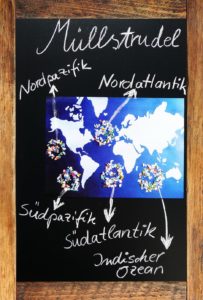At present there are 5 known large areas in which masses of rubbish are collated by currents and then go round in circles. They are called gyres or garbage patches.  One often comes across the term „garbage carpet“ which is however misleading, as the rubbish concerned is mostly plastic and is not just on the surface of the oceans but also beneath them; the term „plastic soup“ would be better to demonstrate the form of these areas. Plastic can float for centuries in the oceans, whereby the pieces of plastic get broken into ever smaller pieces by waves and the sun.
One often comes across the term „garbage carpet“ which is however misleading, as the rubbish concerned is mostly plastic and is not just on the surface of the oceans but also beneath them; the term „plastic soup“ would be better to demonstrate the form of these areas. Plastic can float for centuries in the oceans, whereby the pieces of plastic get broken into ever smaller pieces by waves and the sun.
Floating rubbish is to be found worldwide on coastlines and the high seas. In the media the most well-known are the big maelstrom of rubbish in the North Pacific (North Pacific Gyre or Great Pacific Garbage Patch), which is apparently the size of Central Europe or twice the size of Texas. Sizes like this are to be taken with a pinch of salt and are under discussion among scientists. In the meantime large areas of rubbish have been found in other oceans but scientists point out that further research is required. As the system of currents in the oceans is not constant the flow conditions change continuously and with them the positions and shapes of the gyres.
Further informations
On the English website: http://5gyres.org there are clear information about these: http://5gyres.org/what_is_the_issue/the_problem/
Here you can also find demonstrative information:
http://www.plasticgarbageproject.org/de/plasticgarbage-project/ travelling exhibition “terminus ocean? The plastic rubbish project”
http://www.plasticgarbageproject.org/de/plastikmuell/probleme/plastikmuellstrudel/
The German Federal Environmental Agency also has a lot of information:
http://www.umweltbundesamt.de/themen/wasser/gewaesser/meere/nutzung-belastungen/muell-im-meer

